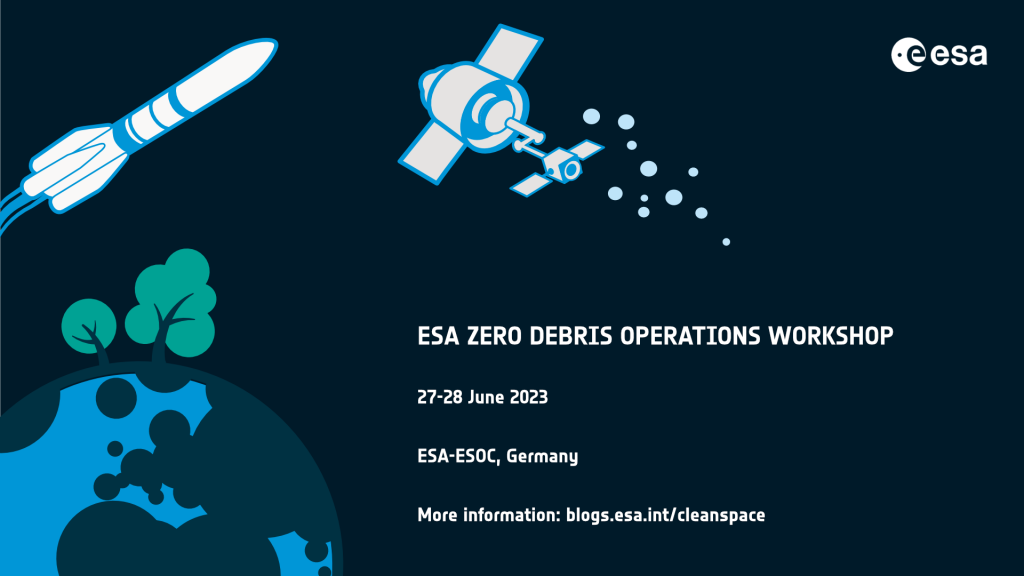ESA invites operators, manufacturers and integrators to join a 2-day workshop on the Zero Debris approach. The 1st ESA Zero Debris Operations Workshop, in ESOC on the 27th and 28th of June 2023, aims to engage the European space sector to collectively develop the Zero Debris approach and bring Europe to the forefront of space sustainability.
The ESA Zero Debris approach embodies the Agency’s commitment to lead by example on the long-term sustainability of space. Building upon the work done by the Space Safety Programme, ESA aims to develop and implement by 2030 the most ambitious commitments on space debris mitigation and remediation, and stop the generation of debris in valuable orbits.

Zero Debris is a key element of ESA’s Agenda 2025 and the ESA PROTECT accelerator, which strive to foster the European leadership in zero-debris space activities, thereby promoting the long-term international competitiveness of the European space industry.
As the ESA Zero Debris Approach requires the involvement of all key players in building and operating a space mission, from design to end-of-life, we are organizing dedicated workshops with all concerned segments, starting with the Operations community.
The workshop will focus on improving operations towards Zero Debris This goal is also a crucial element of the new ESA Space Debris Mitigation standard that is currently under development.
The first step to improve operations towards zero debris is to identify gaps related to operations and the supporting space and ground segments. The second is to consolidate the technical and operational recommendations, requirements, and technology roadmaps.
For this, the key is to closely work with the experts, naming for this workshop specifically: ground operators, space segment operators, and system integrators.
On Tuesday 27, the workshop will start with a presentation of the Zero Debris approach and ESA’s proposal to initiate a global Zero Debris charter.
Then, working sessions will take place to consolidate the Zero Debris approach and discuss important topics such as collision avoidance, reliable disposal operations, failure prediction, mission plan re-evaluation, and space traffic coordination.
Registrations
The event is open to entities from ESA Member States, Cooperating States and Associate States. Please note that to run a productive workshop, ESA has decided to limit the number of attendees. Therefore, the registrations will be monitored and depending on the number of registrations ESA allows itself to accept or decline the registration. Priority will be given to operators and system integrators.
Participation is free of charge, but registration is required. Please register online on the event webpage. We look forward to your participation!





Discussion: 2 comments
Hello,
I have applied for the workshop because I am really interested in this area and have already worked on debris removal project where we discussed the application of a laser to lower the orbit of debris such that it burns in the atmosphere due to the drag forces. Currently, I’m working as a Laser Service Engineer in London and remain interested in working further on my project. I believe this workshop will provide me a good platform for future research and collaboration. I will appreciate if I am selected for this workshop.
Thanks.
Economic consequences for satellites
A collision in orbit can destroy an active satellite, which poses an economic problem. Indeed, billions of dollars worth of weather watch equipment, navigation and communication systems are at stake.
Today, the probability that an Earth observation satellite will be destroyed is 3 to 5% during its lifetime.
For the moment, an acceptable threshold has not been defined, but since the chain reaction mechanism is at work, the population of debris increases, which increases the risks.
A danger for earthlings
These objects undergo several actions when they enter the atmosphere. On the one hand, they are burnt… but more or less well. For example, aluminum melts very well but titanium survives better.
On the other hand, they are braked and space mechanics shows that when an object is braked, it descends.
This is how space debris reaches Earth. 1 to 2 objects larger than 10 cm enter each day, and an integrated object, that is to say a satellite or an upper stage of a rocket, enters each week in an uncontrolled manner.
I am neither an expert nor a scientist but my ideas and projects have always had success and now my association would like to contribute to space development projects for the protection of humanity, space and earth.